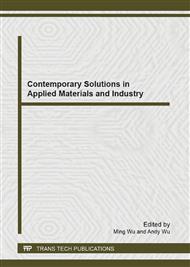[1]
K. Spencer, O. Enofe and N.J. Cowans: Prenatal Diagnosis Vol. 29 (2009), p.1045.
Google Scholar
[2]
L.A. Cole, S.A. Butler and S.A. Khanlian: Gynecologic Oncology. Vol. 102 (2006), p.151.
Google Scholar
[3]
L.G. Kerkmeijer, C.M. Thomas, R. Harvey and F. C: Sweep. British J. Canc. Vol. 100 (2009), p.979.
Google Scholar
[4]
N.E. Van Trommel and H.N. Duc: Int. J. Gynecolog. Canc. Vol. 18 (2008), p.318.
Google Scholar
[5]
J.L. Vaitukatitis, G.D. Braunstein and G.T. Ross: Am. J. Obstet. Gynecolog. Vol. 113 (1972), p.751.
Google Scholar
[6]
J. Chen, F. Yan, D. Du, J. Wu and H.X. Ju: Electroanalysis Vol. 18 (2006), p.670.
Google Scholar
[7]
H.C. Yang, R. Yuan and Y.Q. Chai: Electrochim. Acta Vol. 56 (2011), p. (1973).
Google Scholar
[8]
J. Wu, F. Yan, J.H. Tang, C. Zhai and H.X. Ju: Clin. Chem. Vol. 53 (2007), p.1495.
Google Scholar
[9]
G. Hudelist, P. Wuelfing: K. Czerwenka: Clin. Oncolog. Vol. 135 (2009), p.191.
Google Scholar
[10]
H.S. Kim: J.C. Pyun: Procedia Chemistry Vol. 1 (2009), p.1043.
Google Scholar
[11]
L. Luo, Z.J. Zhang, L.Y. Hou, J.L. Wang and W. Tian: Talanta Vol. 72 (2007), p.1293.
Google Scholar
[12]
L.A. Cole, S.A. Khanlian, C.Y. Muller: Gynec. Oncolog. Vol. 102 (2006), p.160.
Google Scholar
[13]
A.H. Liang, M.L. Tang, Y.F. Tang, Q.Y. Liu and Z.L. Jiang: Anal. Lett. Vol. 44 (2011), p.2162.
Google Scholar
[14]
G.A. Robinson, H.A. Hill, R.D. Philo and J.M. Gear: Clin. Chem. Vol. 31 (1985), p.1449.
Google Scholar
[15]
X.Y. Guo, Y.P. Guan, B. Yang and Y.N. Wang: Int. J. Mol. Sci. Vol. 7 (2006), p.274.
Google Scholar
[16]
Z.L. Jiang, M.J. Zou and A.H. Liang: Clin. Chem. Acta Vol. 387 (2008), p.24.
Google Scholar
[17]
A.H. Liang, M.J. Zou and Z.L. Jiang: Talanta Vol. 75 (2008), p.1214.
Google Scholar
[18]
Z.L. Jiang, Y.J. Huang and A.H. Liang: Biosens. Bioelectron. Vol. 24 (2009), p.1674.
Google Scholar
[19]
Z. L Jiang, X.J. Liao, A.P. Deng, A.H. Liang and J.S. Li: Anal. Chem. Vol. 80 (2008), p.8681.
Google Scholar
[20]
Z.L. Jiang, W.X. Huang, J.P. Li and M.S. Li: Clin. Chem. 54 (2008), p.116.
Google Scholar
[21]
M. Hou, S.J. Sun and Z.L. Jiang: Talanta Vol. 72 (2007), p.463.
Google Scholar


